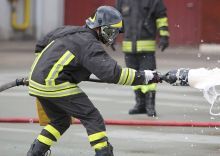It’s time to switch to PFAS-free firefighting foams
By Melanie Benesh | EWG News | April 22, 2020

Read the full article by Melanie Benesh, Legislative Attorney (EWG News)
“Firefighting foam is one of the most significant sources of water contamination from the toxic fluorinated chemicals known as PFAS. PFAS-based firefighting foams have been widely used by the military, fire training centers and airports for five decades, even though the Pentagon has known since the 1970s that PFAS is toxic.
PFAS is the key ingredient in a special kind of firefighting foam – aqueous film-forming foam, or AFFF, typically used on high-heat fuel fires. For decades, AFFF discharged during fire emergencies and routine training exercises has resulted in large releases of PFAS into nearby drinking water sources. In some kinds of training exercises, entire hangars are filled with PFAS-laden AFFF and then released into the environment.’
PFAS are known as ‘forever chemicals,‘ because once released into the environment, they never break down. They also build up in our bodies, where they can stay for decades. PFAS chemicals are associated with cancer, reproductive and developmental harms, and harm to the immune system.
In December, Congress made the historic decision to phase out PFAS in military firefighting foams by 2024. In 2018, Congress directed the Federal Aviation Administration to change its rules so that airports could also switch to PFAS-free foams.
We shouldn’t wait that long.
Viable alternatives to AFFF are already on the market, already meet the international aviation standards used by airports all over the world and should be adopted by the military and airports immediately. As of April 2019, there were more than 100 fluorine-free foams available from 24 manufacturers.
Firefighters in particular should not have to wait. Studies show that firefighters have higher levels of PFAS in their blood serum than the average American.
Fluorine-free foams already meet various internationally accepted certifications and approvals, including the International Civil Aviation Organization Level B, an internal oil industry standard known as LASTFIRE and the International Maritime Organization MSC.1/Circ. 1312.
Although PFAS-based and PFAS-free foams do not perform identically, firefighters can adjust their tactics to ensure the effectiveness of PFAS-free foams. Unfortunately, as Randy Krause, fire chief at Seattle-Tacoma International Airport, explained in testimony before the Washington State Senate, tests often do not account for firefighting tactics and techniques that enhance the performance of fluorine-free foams, making them appear less effective than they are in practice.
Fluorine-free firefighting foams have been available for nearly 20 years, and rapid advances in the technology have been made over the past decade. In 2002, 3M filed the world’s first patent for a fluorine-free firefighting foam. When 3M quit the foam business, it sold the patents to a Norwegian company, Solberg.
PFAS-free foams are already being used successfully by airports, militaries, and oil and chemical companies across the globe.
Fluorine-free foams are used by the Danish and Norwegian armed forces. All 27 major Australian airports have transitioned to fluorine-free foams, as have many major international airports, including London Heathrow and Gatwick, Paris-Charles De Gaulle and Dubai. Fluorine-free foams are used by oil and chemical manufacturers, including BP, ExxonMobil, Statoil, BASF, AkzoNobel, Pfizer and Lilly…”
This content provided by the PFAS Project.
Location:
Topics: